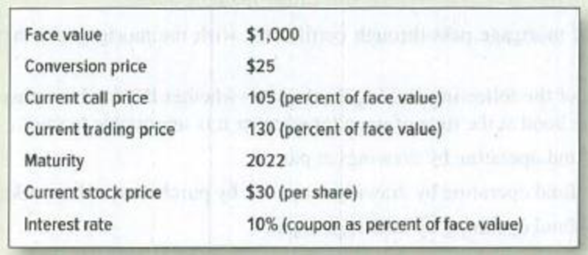
PRIN.OF CORPORATE FINANCE
13th Edition
ISBN: 9781260013900
Author: BREALEY
Publisher: RENT MCG
expand_more
expand_more
format_list_bulleted
Textbook Question
Chapter 24, Problem 18PS
Convertible bonds The Surplus Value Company had $10 million (face value) of convertible bonds outstanding in 2015. Each bond has the following features.

- a. What is the bond’s conversion value?
- b. Can you explain why the bond is selling above conversion value?
- c. Should Surplus call? What will happen if it does so?
Expert Solution & Answer
Want to see the full answer?
Check out a sample textbook solution
Students have asked these similar questions
10. Calculate the break-even point for a company with fixed costs $10,000, variable costs $5/unit, and selling price $10/unit.
no gpt ..???
7. If sales are $500,000 and gross profit margin is 30%, what is the cost of goods sold?
3. If a stock's beta is 1.5 and the market return is 12%, with a risk-free rate of 4%, what is the expected return?
Chapter 24 Solutions
PRIN.OF CORPORATE FINANCE
Ch. 24 - Bond terms Use Table 24.1 (but not the text) to...Ch. 24 - Bond terms Look at Table 24.1: a. The AMAT bond...Ch. 24 - Bond terms Select the most appropriate term from...Ch. 24 - Prob. 5PSCh. 24 - Bond terms Bond prices can fall either because of...Ch. 24 - Security and seniority a. As a senior bondholder,...Ch. 24 - Prob. 8PSCh. 24 - Prob. 9PSCh. 24 - Security and seniority a. Residential mortgages...Ch. 24 - Sinking funds For each of the following sinking...
Ch. 24 - Call provisions a. Look at Table 24.1. Suppose...Ch. 24 - Covenants Alpha Corp. is prohibited from issuing...Ch. 24 - Prob. 14PSCh. 24 - Private placements Explain the three principal...Ch. 24 - Convertible bonds True or false? a. Convertible...Ch. 24 - Convertible bonds Maple Aircraft has issued a 4%...Ch. 24 - Convertible bonds The Surplus Value Company had 10...Ch. 24 - Prob. 19PSCh. 24 - Convertible bonds Iota Microsystems 10%...Ch. 24 - Convertible bonds Zenco Inc. is financed by 3...Ch. 24 - Prob. 22PSCh. 24 - Prob. 23PSCh. 24 - Bank loans, commercial paper, and medium-term...Ch. 24 - Prob. 25PSCh. 24 - Tax benefits Dorlcote Milling has outstanding a 1...Ch. 24 - Convertible bonds This question illustrates that...Ch. 24 - Prob. 28PS
Knowledge Booster
Learn more about
Need a deep-dive on the concept behind this application? Look no further. Learn more about this topic, finance and related others by exploring similar questions and additional content below.Similar questions
- 4. A company has $100,000 in assets and $50,000 in liabilities. What is its equity? Need a helpful..???arrow_forward4. A company has a debt-to-equity ratio of 1:2. If debt is $200,000, what is equity?arrow_forward9. If a company's current ratio is 2 and its current liabilities are $50,000, what are its current assets?no chatgpt???arrow_forward
- 5. Calculate the return on equity (ROE) for a company with net income $150,000 and equity $750,000.arrow_forward6. What is the price of a bond with face value $1,000, coupon rate 8%, and market interest rate 10%?arrow_forward9. A company has fixed costs $50,000, variable costs $10/unit, and sells products at $20/unit. What is the break-even point?arrow_forward
- 8. Calculate the weighted average cost of capital (WACC) for a company with 60% equity (cost 12%) and 40% debt (cost 8%). no gpt ..???arrow_forward8. Calculate the weighted average cost of capital (WACC) for a company with 60% equity (cost 12%) and 40% debt (cost 8%). Need a helpful..??arrow_forward3. If a company's net income is $100,000 and it has 10,000 shares outstanding, what is the earnings per share (EPS)? Correctly answer..???arrow_forward
- 10. If a stock's dividend yield is 5% and stock price is $100, what is the annual dividend payment? no gpt..???arrow_forward8. A stock has a beta of 1.2 and the market return is 10%. If the risk-free rate is 2%, what is the expected return? need a ai ..???arrow_forwardA corporation buys on terms of 2/8, net 45 days, it does not take discountes, and it actually pays after 62 days, what is the effective annual percentage cost of its non-free trade credit? Use a 365-day year) keep to the 6th decimal place for accuracyarrow_forward
arrow_back_ios
SEE MORE QUESTIONS
arrow_forward_ios
Recommended textbooks for you
 EBK CONTEMPORARY FINANCIAL MANAGEMENTFinanceISBN:9781337514835Author:MOYERPublisher:CENGAGE LEARNING - CONSIGNMENT
EBK CONTEMPORARY FINANCIAL MANAGEMENTFinanceISBN:9781337514835Author:MOYERPublisher:CENGAGE LEARNING - CONSIGNMENT Intermediate Financial Management (MindTap Course...FinanceISBN:9781337395083Author:Eugene F. Brigham, Phillip R. DavesPublisher:Cengage Learning
Intermediate Financial Management (MindTap Course...FinanceISBN:9781337395083Author:Eugene F. Brigham, Phillip R. DavesPublisher:Cengage Learning

EBK CONTEMPORARY FINANCIAL MANAGEMENT
Finance
ISBN:9781337514835
Author:MOYER
Publisher:CENGAGE LEARNING - CONSIGNMENT

Intermediate Financial Management (MindTap Course...
Finance
ISBN:9781337395083
Author:Eugene F. Brigham, Phillip R. Daves
Publisher:Cengage Learning
What happens to my bond when interest rates rise?; Author: The Financial Pipeline;https://www.youtube.com/watch?v=6uaXlI4CLOs;License: Standard Youtube License